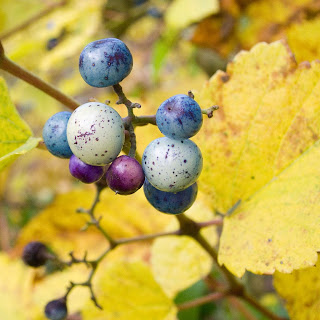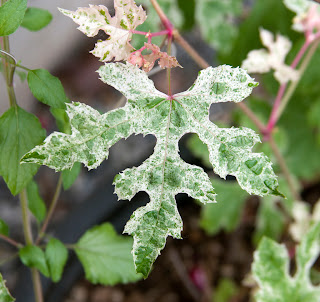According to the Center for Invasive Species and Ecosystem Health the definition of an invasive species is, any species, including its seeds, eggs, spores or other biological material capable of propagating that species, that is not native to the ecosystem; and whose introduction does or is likely to cause economic or environmental harm or harm to human health.
I first noticed Porcelain Berry while I was birding at Milltown Landing in Prince George's County, MD. The plant with its striking multicolored berries was entangled throughout a long hedgerow. I snapped a few photos so I could identify the plant when I got home.

Photo: Sharon Brogan
Later in the evening after I had looked at my photos I realized that I was dealing with Porcelain Berry (Ampelopsis brevipedunculata) an exotic vine that is labeled as invasive by the state of Maryland and many other states on the east coast.
In the 1870's Porcelain Berry (also known as Amur Peppervine) was introduced to the eastern United States from northeastern Asia. It was imported as a bedding / landscape plant. Since the first introduction, Porcelain Berry has spread to 18 states.

Like our native grapes, Porcelain Berry is part of the family Vitaceae. It is a deciduous woody vine that grows very quickly and can completely smother native plants with its vigorous blanket-like growth. Porcelain Berry grows best in full sunlight or partial sun. It is most often observed growing along forest edges or along streams and ponds. A single plant can grow 20' in one growing season. Its growth can completely take over an eco-system. On the USDA Forest Service website, they write, ... [Porcelain Berry] has become so abundant in Rock Creek National Park in Washington, DC that an Allegheny blackberry/porcelainberry (Rubus allegheniensis/Ampelopsis brevipedunculata) shrubland vegetation type has been described.
Unfortunately, many birds and mammals like American Robins and White-tailed Deer enjoy the taste of the fruit of Porcelain Berry and help disperse the seeds.

Photo: Steve Fernie

Photo: Don Rogers
Porcelain Berry is easy to identify, especially when it is in fruit. The plant normally bears fruit from September through November. Young fruit of Porcelain Berry is white. As the fruit matures it turns blue or purple and is usually speckled. Our native grapes, when young, are always green and turn to a deep purple or black. The flesh of Porcelain Berry fruit is white whereas our native grapes have dark flesh. Below is a photo of our native Fox Grape (Vitis labrusca). The fruit is much darker than Porcelain Berry and is not speckled.

Photo: Justin Tso
Another way to differentiate between Porcelain Berry and our native grapes is by examining the vines. In the publication Mistaken Identity? Invasive Plants and their Look-Alikes, the authors point out that on the mature vines of our native grapes the bark can be peeled in narrow strips while the bark of Porcelain Berry can not be peeled easily. It is also noted in Mistaken Identity? that the pith of the of the vine is white in Porcelain Berry and brown in our native grapes. One other point in identifying Porcelain Berry is that mature leaves have three to five deep lobes and are often variegated like the photo below.

Photo: Jess Hirsch
I believe it is very important to be able to identify invasive species. It is important not to buy or plant an invasive. Remember that even though you can control the physical structure of a plant that is in your yard landscape, you can't control the Robin that eats the fruit then flies over to the state forest a few miles away and defecates the seeds in a meadow.
Resources on Porcelain Berry and other invasive plants:
Sarver, Treher, et al., Mistaken Identity? Invasive Plants and their Native Look-Alikes, Delaware Department of Agriculture, 2008.
USDA Forest Service: http://www.fs.fed.us/database/feis/plants/vine/ampbre/all.html
The USDA Forest Service publishes on its website "Weed of the Week." Porcelain Berry was featured in 2006: www.invasive.org/weedcd/pdfs/wow/porcelain-berry.pdf
Invasive Plant Atlas, Porcelain Berry page: http://www.invasiveplantatlas.org/subject.html?sub=3007
USDA plant profile, Porcelain Berry: http://plants.usda.gov/java/profile?symbol=AMBR7
Center for Invasive Species and Ecosystem Health: http://www.invasive.org/
The photos used in this post were used from Flickr Creative Commons.
Sharon Brogan: http://www.flickr.com/photos/sbmontana/
Steve Fernie: http://www.flickr.com/photos/albinoflea/
Don Rogers: http://www.flickr.com/photos/dsrogers/
Jess Hirsch: http://www.flickr.com/photos/jhirsch/
Justin Tso: http://www.flickr.com/photos/53859531@N05/
Jim,
ReplyDeleteNow, enlightened by your post, realize I have been cultivating a beautiful patch of Porcelain Berry in my yard the last few years. The fruit is quite attractive but believe I will tear it out and see if I can find some native wild grape vines to replace it with. Great info.
Andy Martin
Gaithersburg, MD